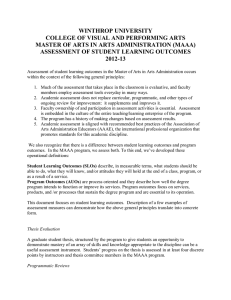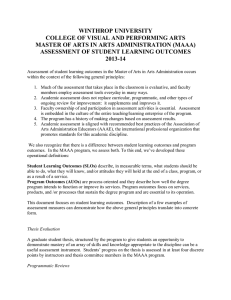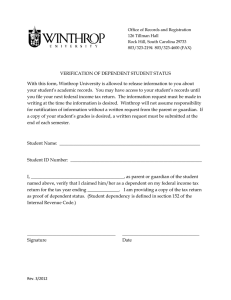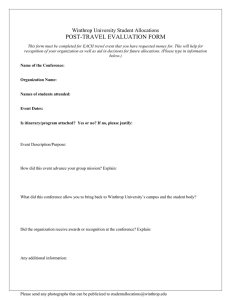WINTHROP UNIVERSITY COLLEGE OF VISUAL AND PERFORMING ARTS
advertisement
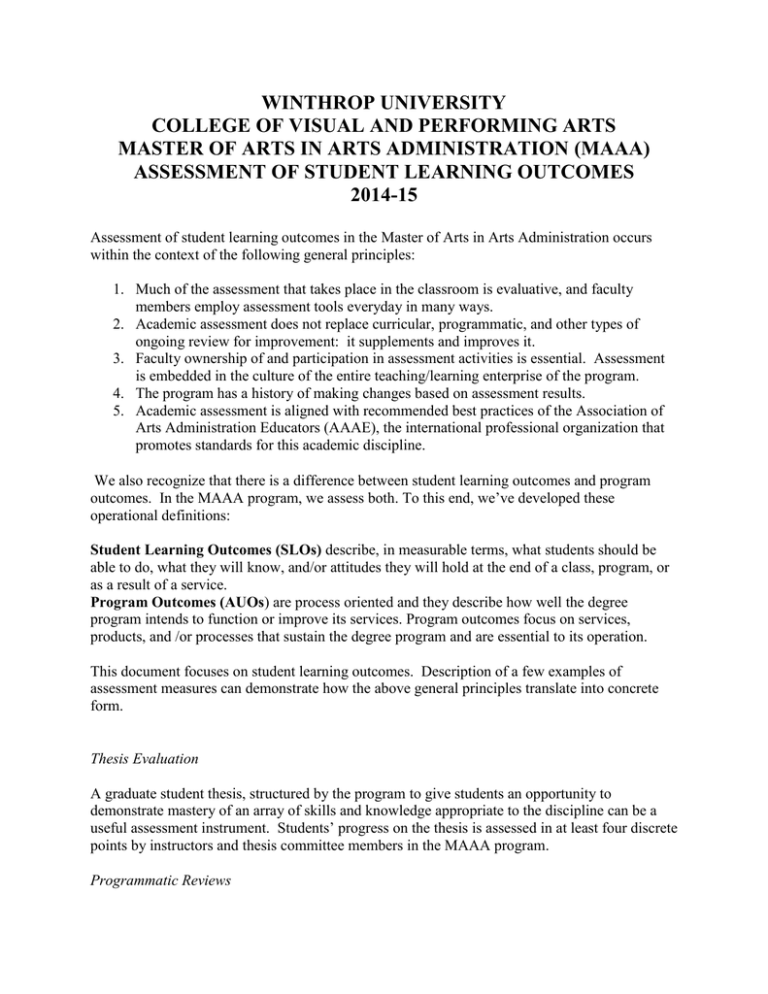
WINTHROP UNIVERSITY COLLEGE OF VISUAL AND PERFORMING ARTS MASTER OF ARTS IN ARTS ADMINISTRATION (MAAA) ASSESSMENT OF STUDENT LEARNING OUTCOMES 2014-15 Assessment of student learning outcomes in the Master of Arts in Arts Administration occurs within the context of the following general principles: 1. Much of the assessment that takes place in the classroom is evaluative, and faculty members employ assessment tools everyday in many ways. 2. Academic assessment does not replace curricular, programmatic, and other types of ongoing review for improvement: it supplements and improves it. 3. Faculty ownership of and participation in assessment activities is essential. Assessment is embedded in the culture of the entire teaching/learning enterprise of the program. 4. The program has a history of making changes based on assessment results. 5. Academic assessment is aligned with recommended best practices of the Association of Arts Administration Educators (AAAE), the international professional organization that promotes standards for this academic discipline. We also recognize that there is a difference between student learning outcomes and program outcomes. In the MAAA program, we assess both. To this end, we’ve developed these operational definitions: Student Learning Outcomes (SLOs) describe, in measurable terms, what students should be able to do, what they will know, and/or attitudes they will hold at the end of a class, program, or as a result of a service. Program Outcomes (AUOs) are process oriented and they describe how well the degree program intends to function or improve its services. Program outcomes focus on services, products, and /or processes that sustain the degree program and are essential to its operation. This document focuses on student learning outcomes. Description of a few examples of assessment measures can demonstrate how the above general principles translate into concrete form. Thesis Evaluation A graduate student thesis, structured by the program to give students an opportunity to demonstrate mastery of an array of skills and knowledge appropriate to the discipline can be a useful assessment instrument. Students’ progress on the thesis is assessed in at least four discrete points by instructors and thesis committee members in the MAAA program. Programmatic Reviews The MAAA program utilizes external program reviews, as it does not have national accreditation standards. Peer review of academic programs is a widely accepted method for assessing curricular sequences, course development and delivery, and the effectiveness of faculty. Using external reviewers is a useful way of analyzing whether student achievement correlates appropriately with departmental goals and objectives. Recommendations initiated by skilled external reviewers can be instrumental in identifying program strengths and weaknesses leading to substantial curricular and structural changes and improvements. Winthrop University is a member of the Association of Arts Administration Educators (AAAE), the international professional organization that promotes standards of education in arts administration. While AAAE does not function as an accrediting organization, it offers many of the services of such a body. These services include: an annual national convention; consultative visits for external review; published guidelines concerning curriculum, faculty credentials, assessment, and best practices. In 2011 the CVPA dean relied upon AAAE to recommend a consultant to visit the Winthrop campus. That consultant’s report generated substantial improvements that are still being implemented through the 2014-15 year. Winthrop’s academic planning process requires all programs to include discussion of assessment strategies in the planning process for all new undergraduate and graduate programs. The MAAA program’s annual report to the dean includes a section on assessment. This program report serves as the foundation for the dean’s annual report to the Vice President for Academic Affairs. Annual Faculty Review The Program Director reviews each faculty member’s goals and record of accomplishment in May for the previous calendar year. Evaluation criteria include teaching, creative/scholarly activity, and service that supports student learning. On the basis of this assessment, faculty members and the Program Director collaboratively consider and design new goals and objectives. Classroom Observation The Program Director observes the instruction of all faculty members at every class session. The Program Director regularly documents observations of instructors’ effectiveness and then meets occurs with the instructors to review the observation/evaluation and make plans for teaching improvements. Administrative Evaluations All faculty members in the program make written evaluations of the Program Director. The dean collects and analyzes the faculty evaluations as one element in a larger, annual review of administrative effectiveness. Annual consultations between the Program Director and the dean occur where they develop a plan for improving administrative skills. Professional Development The Program Director and faculty members regularly attend conferences sponsored by AAAE and various national arts organizations. They also consult with staff members associated with various campus offices, such as the Office of Nationally Competitive Awards, the Academic Success Center, and Dacus Library. All these resources support excellence in the program’s instruction. Placement Placement of graduates in professional positions with non-profit arts organizations (or in forprofit companies or with other kinds of non-profits) is considered in the assessment of program goals. MAAA Advisory Board The program director organized an advisory board for this program. The board is comprised of a) alumni of the program who are working in the non-profit arts field, b) arts leaders in the region, and c) representatives from municipal economic development and the for-profit arts sectors. The members of the advisory board offer their expertise concerning current trends and issues related to arts administration, so that the faculty can make the curriculum as current and relevant as possible. Assessment measures in this program demonstrate that: A. we have an assessment plan that tracks the where, how and when learning occurs for students during their academic careers in the Master of Arts in Arts Administration program at Winthrop. (The Assessment Map) B. the learning that occurs in the program aligns with the broader learning goals of the college, university, and external professional organizations. (Vertical Alignment) C. we always attain the important symbiotic connection between assessment and change. (Closing the Assessment Loop) D. we regularly review all components of our program’s assessment plan (see fifth column of The Assessment Map) A. The Assessment Map in the MAAA Program: ASSESSMENT ACTIVITY ASSESSMENT RESULTS Student Evaluations of Courses (Indirect) Program Director’s Classroom Observation of Instruction (Indirect) Faculty Meetings (Indirect) Student feedback data on instruction ASSESSMENT RESULTS FREQUENCY USED TO MAKE CHANGES IN: Every semester Advising; Pedagogy; curriculum Observation data Every semester by Program Director followed by individual meeting with faculty member Minutes of Every month assessment discussions ASSESSMENT ACTIVITY/TOOL REVIEWED Every five years Pedagogy and course content Every five years Pedagogy; curriculum; Teaching Every semester Assignments Pre-Program Survey (Indirect) Base-line data on student knowledge of program goals Student feedback on program effectiveness Every Fall Exit Survey (Indirect) Student feedback on program effectiveness Every June Reflection Essays (Direct) Arts Event Response (Direct) Professional Development Plan (Direct) Courses Assignments (Direct) Monthly Literature Reviews (Direct) Process Portfolio (Direct) Internship Research Project (Direct) Thesis Proposal (Direct) Student essays Every semester Student essays Every semester Student essays Thesis (Direct) Mid-Program Survey (Indirect) Every Fall Every four years Advising, Pedagogy, curriculum, teaching assignments, policies, course content Advising, Pedagogy, curriculum, teaching assignments, policies, course content Advising; pedagogy; curriculum Course content Every four years Every semester Course content Every four years Student projects Every semester Course content Every two years Student essays Every semester Course content Every four years Advising; curriculum Curriculum; thesis policies Every four years Advising; curriculum; thesis policies Advising; curriculum; thesis policies Every four years Student portfolios Every semester Student research data Every year Student projects Every year Student theses Every year Every four years Every four years Every four years Every four years Every four years The Program Director manages the above assessment tools consistently and regularly, as the third column in the chart indicates. The program’s faculty members meet at least once per month during the academic year and in a retreat at the end of the academic year. They review assessment data and implement change in those meetings. B. Vertical alignment of learning goals: The specific program mission and goals align with CVPA, university, and the AAAE professional organization missions and goals. MAAA Mission Statement: The Master of Arts in Arts Administration program combines theoretical study, academic research, and applied practice to prepare reflective leaders to work with professional skill, creative initiative, and humane integrity in non-profit arts environments. MAAA Program Goals 1. To provide students a curriculum of best practices in governance, audience development, financial management, and legal principles pertaining to non-profit arts. 2. To prepare students for leadership roles in community engagement with the arts, arts advocacy, and arts policy development. 3. To explore evolving technologies, global issues, ethical questions, and leadership practices as they relate to non-profit arts. 4. To guide students to successful completion of an individual investigation or applied thesis research project as a culminating experience. The program mission statements and program goals share a focused vision of professional education and a commitment to developing students’ leadership skills. The program’s student learning outcomes, the student learning outcomes for each course, and the student learning outcomes for assignments in each course all connect directly to at least one of the MAAA program goals. CVPA Mission Statement The College of Visual and Performing Arts at Winthrop University offers nationally accredited programs in art, design, theatre, dance, and music, and provides academically challenging instruction in an interdisciplinary environment that inspires and prepares the next generation of artists, educators, scholars, and audiences. We promote intellectual inquiry and collaborative opportunities that encourage each student to develop a uniquely creative vision cultivated through artistry, teaching, scholarship, public performance, and community engagement. The college mission statement asserts that students receive “academically challenging instruction.” The program’s mission statement affirms that we achieve this through “theoretical study, academic research, and applied practice.” The program’s goals also assert that the MAAA program expects its graduates to master “best practices” in the non-profit arts environment and to complete an “individual investigation or applied thesis research project.” The college mission statement and the MAAA program goals both include scholarship and community engagement as two important modes of learning. Relevant Excerpt from the University Mission Statement Winthrop University provides personalized and challenging undergraduate, graduate, and continuing professional education programs of national caliber within a context dedicated to public service to the nation and to the State of South Carolina. The values of service, excellence, diversity, community, and leadership provide the foundation for Winthrop’s continuing development and shape Winthrop’s continuing success. Winthrop students acquire and develop knowledge, skills, capabilities and values that enrich their lives and prepare them to meet the needs and challenges of the contemporary world, including the ability to communicate effectively, appreciate diversity, work collaboratively, synthesize knowledge, solve complex problems and adapt to change. Ongoing assessment of programs and services ensures both that all academic programs challenge students at their highest level of ability and that the library, instructional technology and other academic service areas support courses of study that are consonant with best practices. As a result, Winthrop graduates are eminently well prepared to enter the most competitive graduate or professional schools as well as to be leaders in their chosen professions and in their communities. In the program mission statement, we assert that we are preparing students to assume leadership roles in their profession. This links to the university mission statement’s assertion that “academic programs challenge students at the highest level” as well as the university’s commitment to preparing graduates “to be leaders in their chosen professions and in their communities.” AAAE Graduate Program Goals When completing a graduate degree, students should possess specific core competencies in certain areas including: 1. Financial and audience development, strategic analysis and planning 2. The dynamics and logistics of institutional development related to how art gets presented and produced 3. The legal, ethical, and policy environments for the arts 4. Leadership in complex organizational environments including the dynamics of working with boards, organizational structure and staffing, and working with artists and other constituencies 5. The international environment for the arts and the impact of the global economy 6. The application of research methodologies to the field including the ability to conceptualize, analyze, synthesize, and evaluate data The program goals include all the core competencies outlined in the AAAE program goals. C. Closing the Assessment Loop Specific Assessment Activity in 2014-15 Curriculum revision o Revision of course descriptions and course goals for ARTA 600 and 610. That could mean some shifting of course content between the two courses for fall 2015. Review of the effectiveness of specific course assignments in ARTA 600 through 670 review of the effectiveness of the professional development plan—as per the cycle of review schedule. Implementation in the 2014-15 year the following enhancements to the curriculum o Revision of the “three questions” standing assignment o Using newly revised rubric for evaluating the thesis first draft in ARTA 696 o New guidelines and rubric for the professional development plan assignment within the Process Portfolio. o New rubric for the arts event critique assignment within the Process Portfolio o New rubric for evaluating the elevator speech assignments in ARTS 670 and in the professional development plan.
